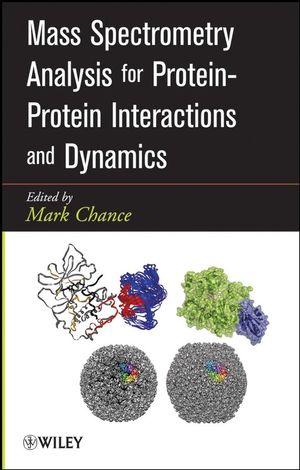Mass Spectrometry Analysis for Protein-Protein Interactions and DynamicsISBN: 978-0-470-25886-6
Hardcover
312 pages
September 2008
 This is a Print-on-Demand title. It will be printed specifically to fill your order. Please allow an additional 15-20 days delivery time. The book is not returnable.
|
||||||
Contributors.
1. Overview of Mass Spectrometry Technologies for Examining Protein Structure: Current and Future Directions (Shannon M. Swiatkowski and Mark R. Chance).
1.1 Introduction.
1.2 Hydrogen/Deuterium Exchange Mass Spectrometry.
1.3 Hydroxyl-Radical-Mediated Protein Footprinting.
1.4 Chemical Cross-linking.
References.
2. Hydrogen Exchange Mass Spectrometry: Principles and Capabilities (Sebastien Brier and John R. Engen).
2.1 The Chemistry of Hydrogen Exchange.
2.2 HX Mechanisms in Proteins.
2.3 Deuterium Incorporation into Proteins.
2.4 Measuring HX with Mass Spectrometry.
2.5 Capabilities of HX MS in Structural Biology.
Acknowledgment.
References.
3. Covalent Labeling Methods for Examining Protein Structure and Protein Interactions (Keiji Takamoto and Janna Kiselar).
3.1 Introduction.
3.2 Chemistry of Hydroxyl Radical Footprinting.
3.3 Mass Spectrometry Approaches for Quantitative Protein Footprinting.
3.4 Examples of Various Methods that Generate Hydroxyl Radicals in Solution to Examine Protein Structure.
3.5 The Future: Hybrid Approaches that Combine Experimental and Computational Data.
References.
4. Complementary Methods for Structure Determination: Hydroxyl-Radical-Mediated Footprinting and Deuterium Exchange Mass Spectrometry as Applied to Serpin Structure (Xiaojing Zheng and Patrick L. Wintrode).
4.1 Introduction.
4.2 Technical Comparison of Hydroxyl-Radical-Mediated Footprinting and H/D Exchange Methodologies.
4.3 Structural Mass Spectrometry Data.
4.4 Solvent Accessibility.
4.5 Dynamics.
4.6 Significance for Serpin Structure and Function.
4.7 Summary.
Acknowledgement.
References.
5. Deuterium Exchange Approaches for Examining Protein Interactions: Case Studies of Complex Formation (Elizabeth A. Komives).
5.1 Interactions of Regulatory and Catalytic Subunits of Protein Kinase A.
5.2 Allostery in Protein-Protein Interactions Revealed by H/D Exchange.
5.3 Interactions of the Inhibitor IkBα with the Transcription Factor NF-kB.
References.
6. Hydrogen/Deuterium Exchange Studies of Viruses (Sebyung Kang and Peter E. Prevelige Jr.).
6.1 Overview of Virus Lifecycles.
6.2 Structural Investigations of Viral Capsids.
6.3 Dynamics of Viral Capsids.
6.4 Hydrogen/Deuterium Exchange Studies of Virus Capsid Structure.
6.5 Hydrogen/Deuterium Exchange Studies of Viral Protein Dyanmics.
6.6 Technical Aspects of Performing Hydrogen/Deuterium Exchange Experiments on Viruses.
References.
7. Use of Enhanced Peptide Amide Hydrogen/Deuterium Exchange-Mass Spectrometry (DXMS) in the Examination of Protein-Protein Interactions (Yoshitomo Hamuro, Stephen J. Coales, Lora L. Hamuro, and Virgil L. Woods Jr.).
7.1 Introduction.
7.2 Theory of H/D Exchange.
7.3 Overview of DXMS Technology for Protein-Protein Interactions.
7.4 DXMS of Human Growth Hormone and Its Binding Protein.
7.5 DXMS of PKA Regulatory Subunits.
7.6 DXMS of PKA R-Submit D/D Domains and D-AKAP2 AKB Domain.
7.7 Epitope Mapping by DXMS.
7.8 Conclusions.
Abbreviations.
Acknowledgements.
References.
8. Cross-linking as a Tool to Examine Protein Complexes: Examples of Cross-linking Strategies and Computational Modeling (Evgeniy V. Petrotchenko and Christoph H. Borchers).
8.1 Introduction.
8.2 Cross-linking Strategies.
8.3 Cross-linking Methodology.
8.4 challenges Associated with Combining Cross-linking with Mass Spectrometry.
8.5 Advances in Mass Spectrometry Instrumentation and Capabilities.
8.6 Novel Cross-linking Reagents for Mass Spectrometry.
8.7 Analytical Software.
8.8 Using Cross-linking Distance Constraints to Build Experimental Models of Protein Complexes.
References.
9. Complex Formation in the Actin Cytoskeleton: Cross-linking Tools to Define Actin Protein Structure and Interactions (Sabrina Benchaar and Emil Reisler).
9.1 Introduction.
9.2 Mapping Cross-linking with Methods Other than Mass Spectrometry.
9.3 Actin-Actin Cross-linking.
9.4 Intrastrand Cross-linked Actin between GLN41 and CYS374.
9.5 Regulation of Cytoskeleton by ABPs and Mapping their Interfaces with Actin by Cross-linking.
9.6 Cross-linking of Actin and Muscle Proteins—Examples of Experimental Approaches.
9.7 Conclusing Remarks.
Acknowledgement.
References.
10. Computational Approaches to Examining Protein-Protein Interactions: Combining Experimental and Computational Data in the Era of Structural Genomics (J.K. Amisha Kamal).
10.1 Interactome in Structural Genomics.
10.2 Importance of Computational Methods in Structural Genomics.
10.3 Combining Computational Method with Experimental Data in Modeling the Structure of Protein Binary Complex.
10.4 Method Summary.
10.5 Experimental Methods.
Acknowledgment.
References.
11. Studies of Intact Proteins and Protein Complexes: ESI MS Approaches (Igor A. Kaltashov, Rinat R. Abzalimov, Agya K. Frimpong, and Stephen J. Eyles).
11.1 Introduction.
11.2 Tertiary Structure Integrity and Conformational Heterogeneity (Charge State Distributions).
11.3 Quaternary Structure Integrity and Composition of Non-Covalent Complexes.
11.4 Functional Competence.
11.5 Flexibility Maps and Binding Interfaces.
11.6 Gas Phase Ion Chemistry and Its Influence of the Measurement of Protein Properties in Solution.
11.7 challenges and Future Outlook.
Acknowledgments.
References.
12. Two Approaches to Mass Spectrometric Protein Footprinting: PLIMSTEX and FPOP (Michael L. Gross, Mei M. Zhu, and David M. Hambly).
12.1 Introduction: Protein-Ligand Interactions by Mass Spectrometry, Titration, and Hydrogen/Deuterium Amide Exchange and Fast Photochemical Oxidation of Proteins.
12.2 Protein-Ligand Interactions by Mass Spectrometry, Titration, and H/D Amide Exchange (PLIMSTEX).
12.3 Applications of PLMSTEX.
12.4 Self-Association of Insulin: A Protein/Protein Interaction.
12.5 Features of PLMSTEX.
12.6 Fast Photochemical Oxidation of Proteins: An Example of Fast Protein Footprinting.
12.7 Features of FPOP.
12.8 Future.
Abbreviations.
Acknowledgments.
References.
Index.



